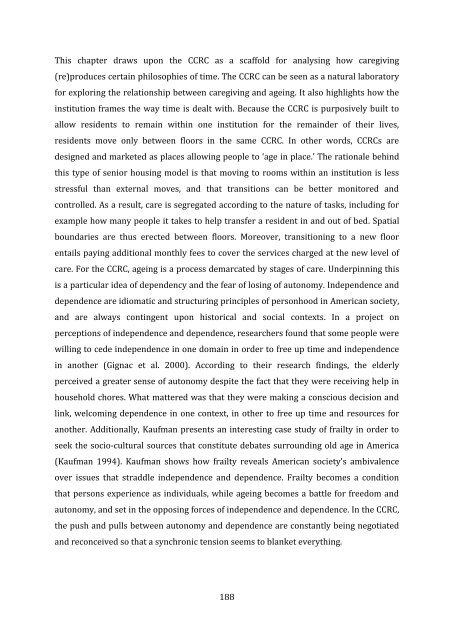Philip Y. Kao PhD thesis - Research@StAndrews:FullText
Philip Y. Kao PhD thesis - Research@StAndrews:FullText
Philip Y. Kao PhD thesis - Research@StAndrews:FullText
You also want an ePaper? Increase the reach of your titles
YUMPU automatically turns print PDFs into web optimized ePapers that Google loves.
This chapter draws upon the CCRC as a scaffold for analysing how caregiving<br />
(re)produces certain philosophies of time. The CCRC can be seen as a natural laboratory<br />
for exploring the relationship between caregiving and ageing. It also highlights how the<br />
institution frames the way time is dealt with. Because the CCRC is purposively built to<br />
allow residents to remain within one institution for the remainder of their lives,<br />
residents move only between floors in the same CCRC. In other words, CCRCs are<br />
designed and marketed as places allowing people to ‘age in place.’ The rationale behind<br />
this type of senior housing model is that moving to rooms within an institution is less<br />
stressful than external moves, and that transitions can be better monitored and<br />
controlled. As a result, care is segregated according to the nature of tasks, including for<br />
example how many people it takes to help transfer a resident in and out of bed. Spatial<br />
boundaries are thus erected between floors. Moreover, transitioning to a new floor<br />
entails paying additional monthly fees to cover the services charged at the new level of<br />
care. For the CCRC, ageing is a process demarcated by stages of care. Underpinning this<br />
is a particular idea of dependency and the fear of losing of autonomy. Independence and<br />
dependence are idiomatic and structuring principles of personhood in American society,<br />
and are always contingent upon historical and social contexts. In a project on<br />
perceptions of independence and dependence, researchers found that some people were<br />
willing to cede independence in one domain in order to free up time and independence<br />
in another (Gignac et al. 2000). According to their research findings, the elderly<br />
perceived a greater sense of autonomy despite the fact that they were receiving help in<br />
household chores. What mattered was that they were making a conscious decision and<br />
link, welcoming dependence in one context, in other to free up time and resources for<br />
another. Additionally, Kaufman presents an interesting case study of frailty in order to<br />
seek the socio-cultural sources that constitute debates surrounding old age in America<br />
(Kaufman 1994). Kaufman shows how frailty reveals American society's ambivalence<br />
over issues that straddle independence and dependence. Frailty becomes a condition<br />
that persons experience as individuals, while ageing becomes a battle for freedom and<br />
autonomy, and set in the opposing forces of independence and dependence. In the CCRC,<br />
the push and pulls between autonomy and dependence are constantly being negotiated<br />
and reconceived so that a synchronic tension seems to blanket everything.<br />
188
















